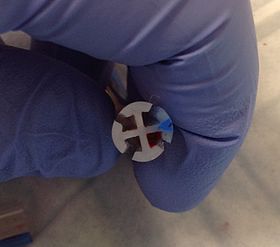Chest drain
| Chest tube | |
|---|---|
| Intervention | |

The free end of the Chest Drainage Device is usually attached to an underwater seal, below the level of the chest. This allows the air or fluid to escape from the pleural space, and prevents anything returning to the chest.
|
|
| ICD-9-CM | 34.04 |
| MeSH | D013907 |
A chest tube (chest drain, thoracic catheter, tube thoracostomy, or intercostal drain) is a flexible plastic tube that is inserted through the chest wall and into the pleural space or mediastinum. It is used to remove air (pneumothorax) or fluid (pleural effusion, blood, chyle), or pus (empyema) from the intrathoracic space. It is also known as a Bülau drain or an intercostal catheter.
The concept of chest drainage was first advocated by Hippocrates when he described the treatment of empyema by means of incision, cautery, and insertion of metal tubes. However, the technique was not widely used until the influenza epidemic of 1917 to drain post-pneumonic empyema, which was first documented by Dr. C. Pope, on "Joel", a 22-month-old infant. The use of chest tubes in postoperative thoracic care was reported in 1922, and they were regularly used post-thoracotomy in World War II, though they were not routinely used for emergency tube thoracostomy following acute trauma until the Korean War.
Contraindications to chest tube placement include refractory coagulopathy and presence of a diaphragmatic hernia, as well as hepatic hydrothorax. Additional contraindications include scarring in the pleural space (adhesions).
The most frequent complication associated with chest tubes is chest tube clogging, which is commonly caused by thrombus formation inside the chest tube, and can cause major subsequent complications. After cardiac surgery, chest tube clogging has been observed in 36% of patients, and is significantly associated with increased rates of atrial fibrillation and renal failure. Since a portion of the chest tube is inside the patient, 86% of the time chest tube clogging goes unobserved. In the setting of bleeding, chest tube clogging can cause blood to be retained around the heart and lungs, known as retained blood syndrome, or RBS. This can lead to a complex of complications including pericardial tamponade, hemothorax, pleural effusion, decreased cardiac output, and death. In the presence of air production, chest tube clogging can cause tension pneumothorax, and in the setting of infection, empyema. Chest tube clogging after cardiac surgery is more common in reoperations and urgent procedures, and is associated with statistically significantly higher rates of atrial fibrillation. The composite of complications caused by clogged chest tubes is referred to as Retained Blood Syndrome.
...
Wikipedia
